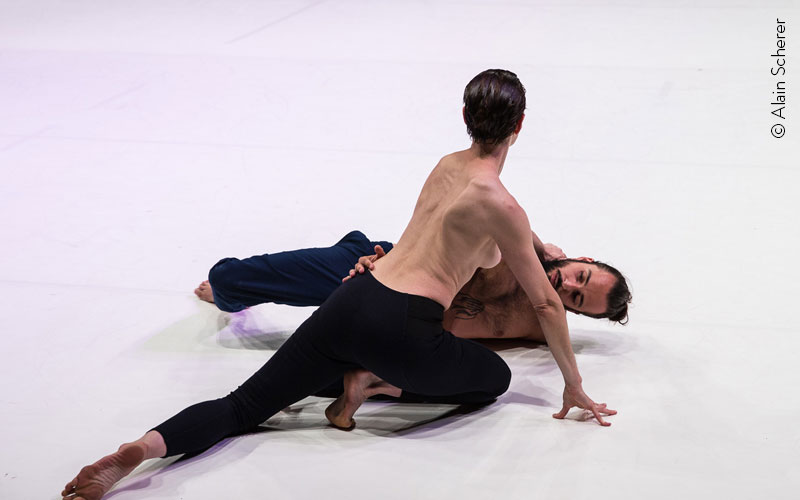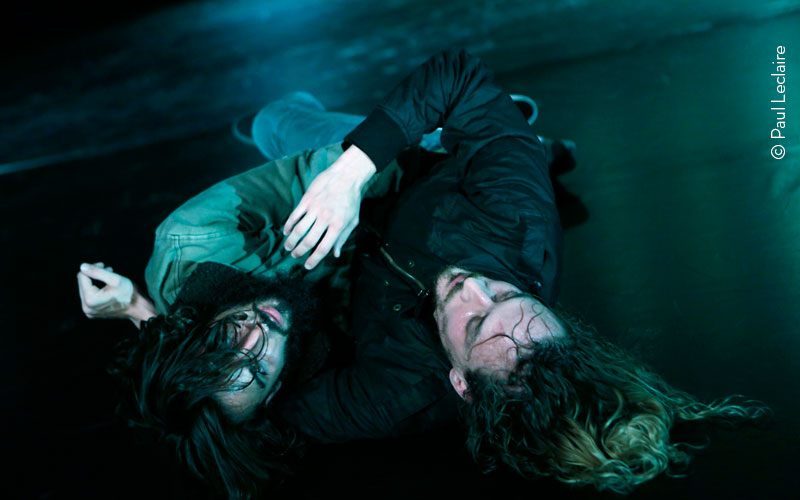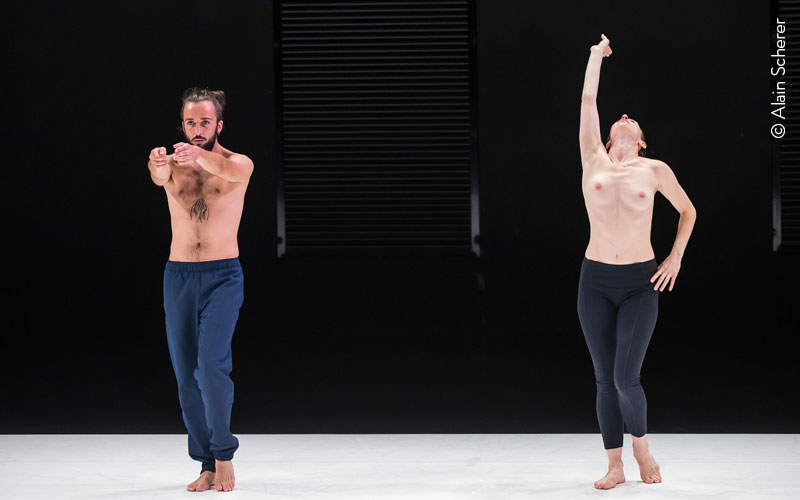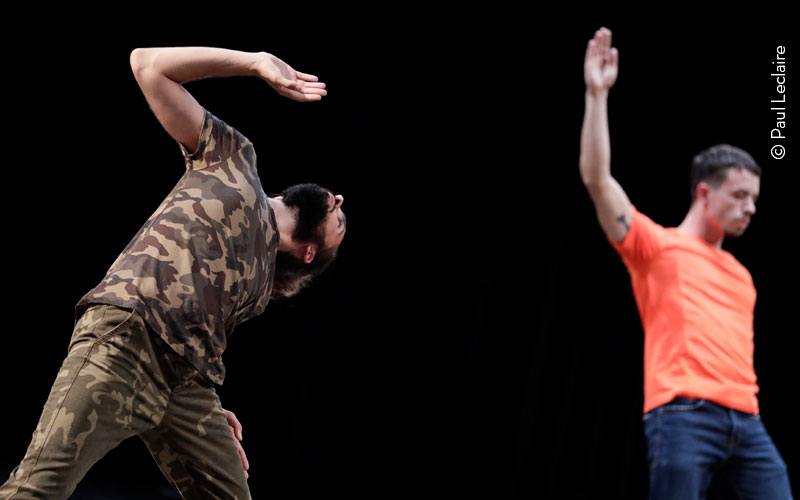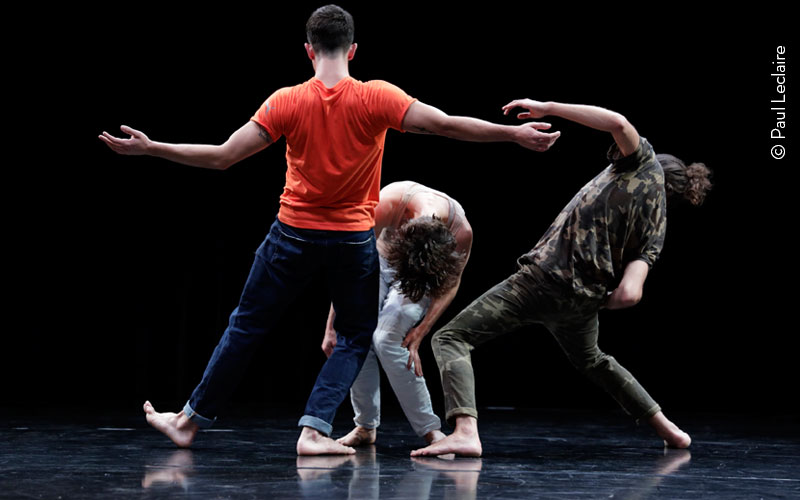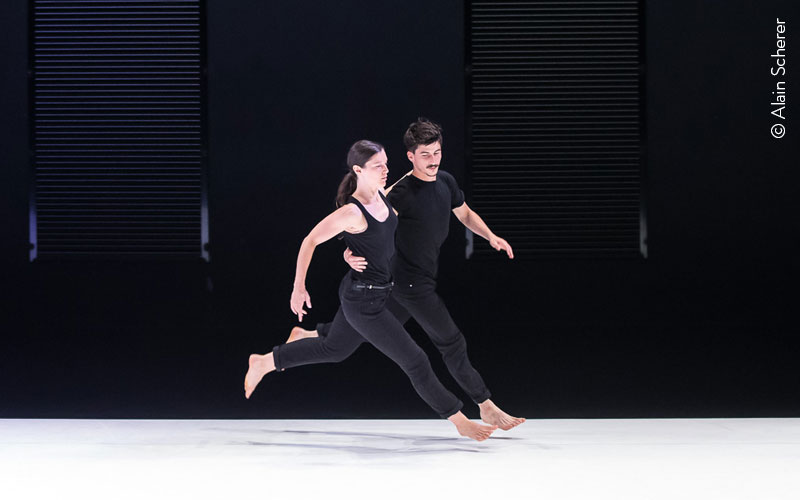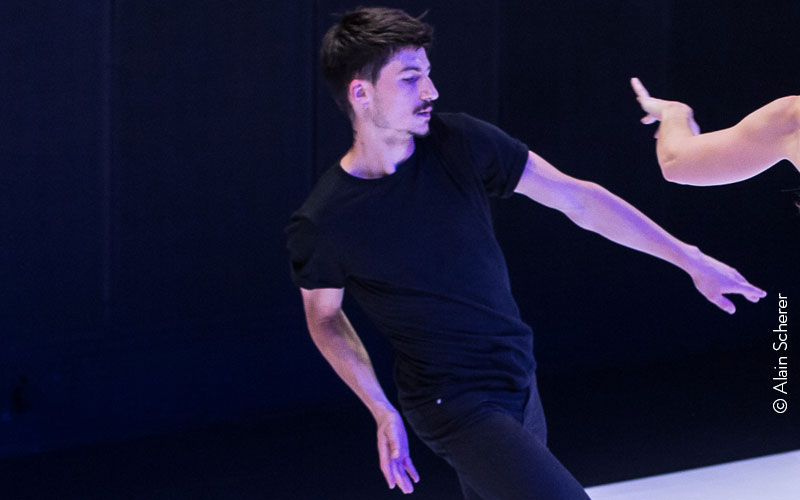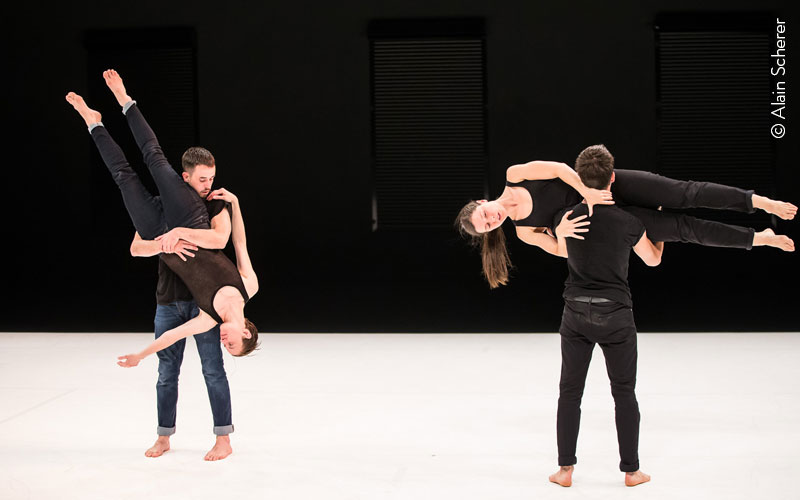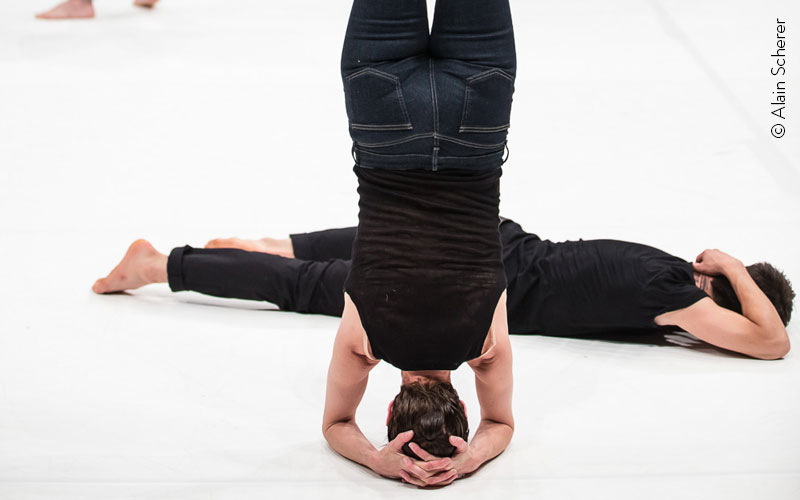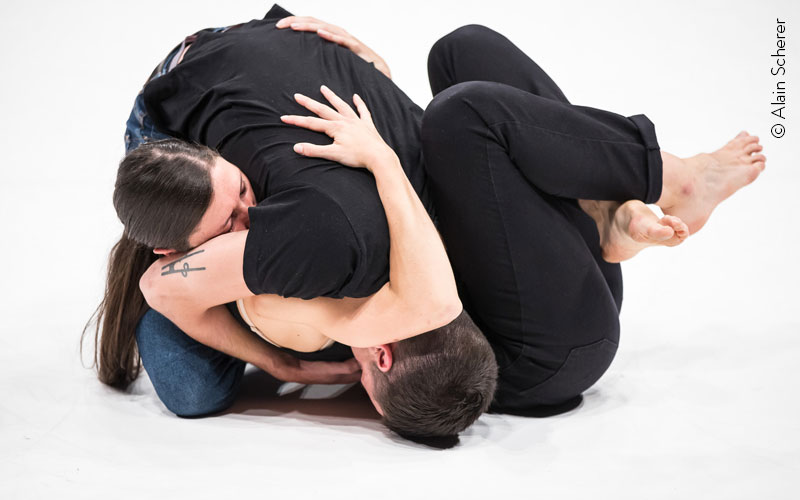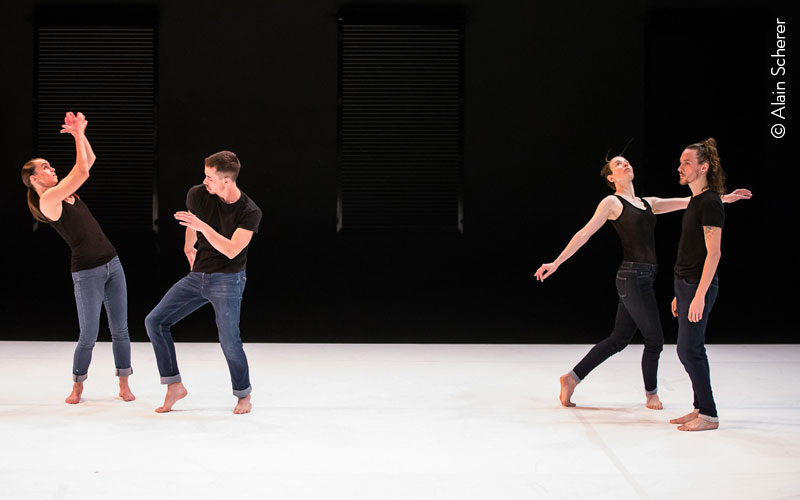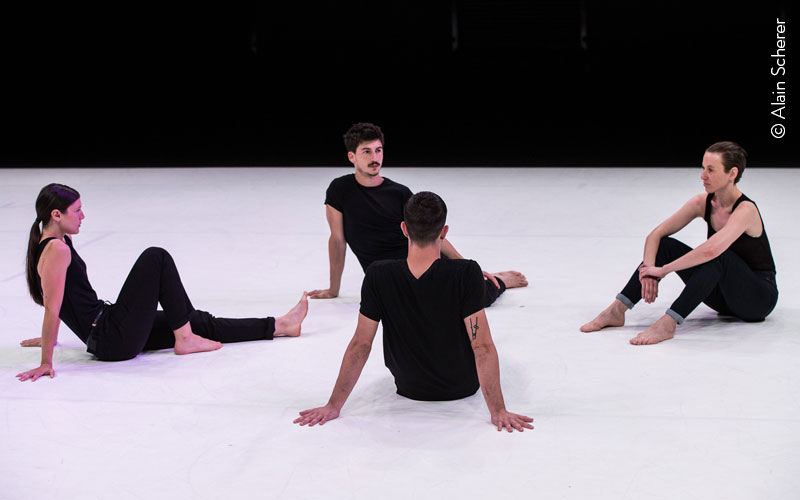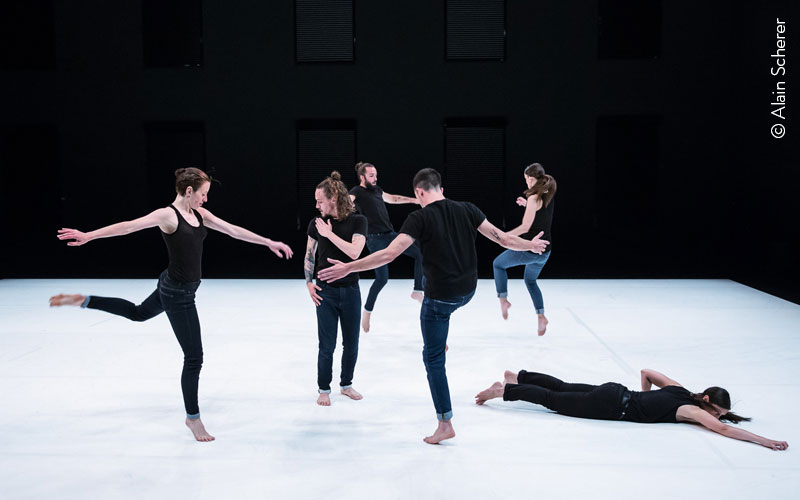The ATLAS / STUDIES project consists in ten short pieces concerned with the body and its representations, resonating with our times. The question at the heart of this work: What stories can bodies, dance and choreography tell, and how can we perform these in ten different ways?
These short dance pieces (maximum 20 minutes each) are independent and can be performed separately. But all are linked through form, inspired by the study such as one finds in painting or music, as well as through content about body representation, energy, modern myths in the world of today.
They function like snapshots, travelling between abstraction and narrative fragments. Together, they form a “choreographic atlas” of contemporary bodies and the stories they tell.
Michèle Murray
ARTISTIC DIRECTION, CONCEPT: MICHELE MURRAY
ARTISTIC COLLABORATION: MAYA BROSCH, MARIE LECA
PERFORMERS: ALEXANDRE BACHELARD, LEO GRAS alternating with MARIE LECA , VIVIEN KOVARBASIC, BAPTISTE MENARD, MANUEL MOLINO, JONATHAN SANCHEZ, LEA VINETTE (Performers at Premiere KIM CEYSENS, ELODIE FUSTER PUIG, FELIX MAURIN)
MUSIC: ANGELO BADALAMENTI, GLENN BRANCA, JOHN FAHEY, KEIJI HAINO, GEROME NOX, BERNARD PARMEGIANI, DAVID TUDOR
LIGHTS: CATHERINE NODEN
PARTNERS
PRODUCTION: ASSOCIATION STELLA
COPRODUCTION: FESTIVAL MONTPELLIER DANSE 2018 / ZENTRUM ZEITGENÖSSISCHER TANZ- HOCHSCHULE FÜR MUSIK UND TANZ KÖLN / ICI –CENTRE CHOREGRAPHIQUE NATIONAL MONTPELLIER OCCITANIE, DIRECTION CHRITIAN RIZZO
WORK RESIDENCIES: MONTPELLIER DANSE – AGORA, CITE INTERNATIONALE DE LA DANSE, WITH THE SUPPORT OF THE FONDATION BNP PARIBAS / ZENTRUM ZEITGENÖSSISCHER TANZ- HOCHSCHULE FÜR MUSIK UND TANZ KÖLN / ESPACE BERNARD GLANDIER MONTPELLIER, COMPAGNIE DIDIER THERON / THEATRE LA CIGALIERE SERIGNAN / LA MENAGERIE DE VERRE IN THE FRAME OF STUDIOLAB
WITH THE SUPPORT OF: LA MAISON – CENTRE DE DEVELOPPEMENT CHOREGRAPHIQUE UZES
PUBLIC SUPPORT: MINISTERE DE LA CULTURE -DIRECTION REGIONALE DES AFFAIRES CULTURELLES OCCITANIE PYRENEES MEDITERRANEE / REGION OCCITANIE PYRENEES- MEDITERRANEE / VILLE DE MONTPELLIER
CONTRIBUTION TO PRODUCTION: CONSEIL GENERAL DE L’HERAULT
SUPPORT FOR TOURING: RESEAU EN SCENE, AU TITRE DE L’AIDE A LA MOBILITE ET DE L’INSTITUT FRANÇAIS
PRESSE ATLAS / STUDIES
Klaus DILGER, Tanzweb.org, avril 2024 :
THIS QUOTE…
… from the program booklet is remarkable because, unlike most of its kind, it does not reflect “proposal poetry” or the more or less successful wishful thinking of the artists or their dramaturges, but rather amazingly aptly describes one aspect of what visitors can expect if they want to get involved.
At this point, the organizers of this small Bonn dance festival “INTO THE FIELDS” deserve thanks and respect for this, as it also reflects a responsible attitude towards the dance audience, which, as can be observed in many places, can easily be lost if it all too often experiences a lack of understanding and disappointment. Here, however, a kind of initiation and an attempt at disposition emerges with beautiful regularity, all this in the best sense of the term.
Choreography is spatial art
Unlike in the visual arts, choreographic sketches are not two-dimensional “sheets of paper” that take place under similar premises for every viewer, but live in space, similar to musical sketches, also in the inner spaces and their resonance capabilities. And, the sketches have to be passed on from the creators to the performers and their effect is completely dependent on their skills and their ability to bring these sketches to life again and again.
Powerful performers
Over the years and through continuous collaboration, the French-American choreographer Michèle Murray, who lives and works in Montpellier, has developed a whole series of performers who reassemble the ATLAS | STUDIES, of which there are ten so far, in different constellations, space- and site-specific. This creates an ever-changing dramaturgy for each performance. On this evening, in Bonn’s Theater im Ballsaal, five of the ten sketches were each based on a very individual impulse, a constantly differing dynamic and tension, which, when taken further, can give a complete work a completely different direction. These were interpreted by an ensemble of a reliably high standard.
Dramaturgy of the evening
The total of three women and four men performers allows the choreographer a variety of constellations, which, however, always begin and end with an empty, brightly lit space. With this simple principle, the artist creates the element of the circle, which she occasionally transfers quite directly, as in Study #4, the most emotionally charged study, in which the four performers take up the same spatial positions at the beginning and end. (What goes up must come down). The evening thus consists of a quartet, two successive duets, a quartet and ends with a trio, perhaps the best technically danced study, but which seemed angular, edgy and contrived, perhaps also because Merce Cunningham overlaid the signature of Michèle Murray, with whom she had studied in New York. Perhaps, however, the choreographer wanted to neutralize the narrative element that emerged in Study#4, which only seems coherent after viewing the evening.
Everyone experiences the studies in the space differently.
The fact that every spectator experiences these ATLAS | STUDIES differently, depending on their vantage point, becomes particularly clear through the eye of the camera when it is not positioned in the center. In her STUDIES, Murray develops a strong dynamic from the diagonal and the direct “attack” on the audience when they are performed in a theater venue.
The respective sketch is thus created differently in each viewer and is created by the viewer in the room.
CONCLUSION
An exciting, high-quality evening as conclusion the 2024 edition of the INTO THE FIELDS festival in Bonn.
Gérard Mayen / Danser Canal Historique / June 2018 /: Seen on Wednesday 27 June (in two parts) at the Studio Bagouet as part of the 38th Montpellier Dance Festival -“ATLAS / STUDIES” by Michèle Murray. Along with a beautiful cast and set in an ideal location, the choreographer composes an atlas of knowledge and mischief in touch with the zeitgeist.
Nothing ordinary ever happens in the Bagouet dance studio of the National Choreographic Center in Montpellier. Designed in its time by the choreographer Dominique Bagouet, who gave it its name, this theater is the perfect architectural space for dance, in which the audience is included. It’s incredibly stable, vast and calm. Yet at the same time, it seems full of possibilities.
One could not have dreamt of a more appropriate setting for the idea that Michèle Murray works with in her choreography ATLAS / STUDIES, created for the Festival Montpellier Dance Festival (38th edition). Ten studies are performed in two separate series on the same day, each study with its own duration (none lasting longer than twenty minutes) and with a cast of seven performers dancing in different combinations for each study. This means a vast palette in the number of performers on stage (ranging from duets to septets) and genres. It’s a little like a card game which is continually being reshuffled. The very short interludes between studies are clearly marked by the stage being completely emptied ( left with only Catherine Noden’s rough and velvety black lights). At the start of each study, the protagonists step onto the stage and take a firm place, often in a quiet frontal and central position. From this point on, movement variations begin and develop through procedures of contamination or proliferation. This commitment to things is an event in itself (…)(…)Following the principle of inventive relaunch with each new study, the performance is often captivating, at times exhilarating. Each study is an opportunity for reshuffling the cards, constantly rethinking and reimagining new combinations, interrelational modes, observational skills and sharing of energy levels. Something is happening(…)
This particular quality as well as the dancers’ very powerful presence on stage creates excitement und suspense. There is always something at stake when there is suspense. It is quite impossible to recount the abundance of motifs, situations, and techniques performed by these dancers. A playful intelligence emanates from this composition, as well as giving us the opportunity to enjoy the very different physical and moral personalities on stage. One could say that powerful choreographic personalities make their mark on these games that are not entirely without theatricality.
The choreographer claims to have searched for the “mental state of the performer”, where feeling is more important than iterating. The dancers must “incarnate” and not “play -act”. The improvisation practiced it in almost all studies requires this mental state. This goal has also been achieved with an agreeable suspense. In these studies, one finds the essence of our current zeitgeist in a contemporary performance. And we thus often hold our breath.
Lise OTT, Montpellier Dance / June 2018 / How do bodies tell the story of our times? How do they resonate with the world? The fundamental questions Michèle Murray asks in ATLAS / STUDIES are also questions of dance and territory, memory and mythology. The French – American choreographer who trained in ballet in Düsseldorf and contemporary dance in New York with Merce Cunningham, and who is now based in Montpellier, has decided to combine the demands of her abstract and narrative choreography with a reexamination of current dance forms. In 2012, she founds PLAY, a dance company open to other modes of artistic expression while creating projects concerned with the body, with movement and with choreography. This company defines the framework of her research. Guided by the inspiration of the “Mnemosyne” atlas, a collection of images by art historian Aby Warburg, she developed the concept of a personal choreographic atlas consisting in ten short pieces – the last three choreographed especially for Montpellier Danse. As independent pieces coexisting with various musical compositions, including those of Gerome Nox, they are the result of a rigorous and inventive improvisation process, capable of reshuffling the cards of modernity and emancipating themselves from any academism. Pieces to live through and experience, they draw the atlas of a choreographer engaged in a never-before-seen marathon of pure dance. They are full of energy and joy.
ATLAS / STUDY # 2
ATLAS / STUDY # 3
ATLAS / STUDY # 4
ATLAS / STUDY # 4
ATLAS / STUDY # 5
ATLAS / STUDY # 7
ATLAS / STUDY # 9
ATLAS STUDY # 10


